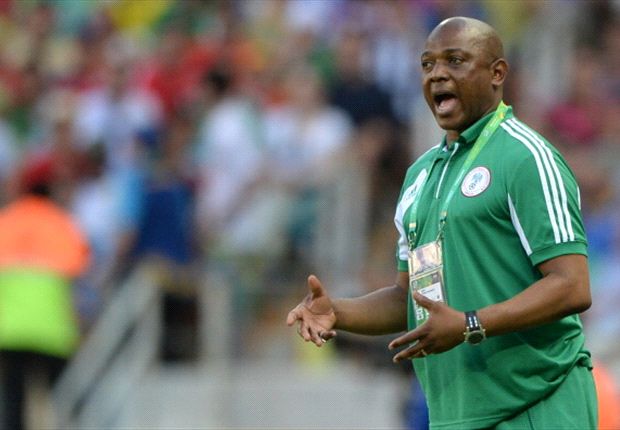
Thousands of Nigerian Football fans would have heaved a deep sigh of relief at what seemed like the denouement of the whole drama that the federation has served up in recent times.
However, there remains a whiff of disbelief that the election of Amaju Pinnick as NFF President is the final episode of the somewhat confusing tale in whole; more confusing than Egyptian Hieroglyphics or, better still, Chinese Mandarin.
Who writes these scripts?
Away from the NFF drama, there’s Stephen Keshi’s forever-taking contractual issue, which should be sorted out in the coming weeks. Those contract talks have taken longer than a defunct rail road.
The Big Boss has proven to be a divisive figure amongst supporters of the Super Eagles, with some clamouring for his return as the head coach and others strongly against his return at the helm but, love him or loathe him; he’s going to be in charge of the double header against the Falcons of Jediane.
But how will he choose to organise his troops during the double-header with Sudan?
It’s a fairly arduous task trying to second-guess whatever the Big Boss has up his sleeves re: tactics. He’s shown to be as unpredictable as weather in some cases and other times to be as predictable as a trashy novel.
Talking Tactics
Keshi hasn’t exactly raked in plaudits for his tactical nous or acumen; in fact certain sections of both fans and the media think he is tactically inept. He isn’t known for the extremely bizarre, so don’t be expecting Helenio Herrera’s Catenaccio, Herbert Chapman’s W-M formation or a Pyramid.
Here are three options that the manager might choose to employ against Sudan.

4-5-1
Nit-pickers and pedants will most likely disagree with the christening of this shape; they’d say 4-2-1-2-1 or whatever else they can come up with.
It’s simply a 4-5-1 with the known back four and Vincent Enyeama returning between the sticks after his exclusion due to personal issues. It’s an identical set-up as that of the World Cup with Nosa Igiebor in the starting XI after injury to Michael Babatunde.
The triumvirate is completed with the known faces of Onazi and Mikel at the base of the midfield.
The slight tweak is that Sone Aluko comes in on the right wing—partly due to Victor Moses’s injury— as an inside forward, making inward, diagonal runs into the box and sometimes doubling up with Emenike up front. The right wing is certainly not his natural position as he is a striker, or more aptly put, a secondary striker, but he has made several appearances on the wing and would put in a decent shift.

3-5-2
Everyone wants a feel of the not-so-more-in-vogue 3-5-2 and Keshi hasn’t trialled it yet.
It worked well for Antonio Conte’s Juventus, Cesare Prandelli’s Italy and Louis van Gaal’s Dutch team, but for Manchester United, not too well. It’s still worth a try anyway.
One problem though, is that it would require Azubuike Egwuekwe to operate as the sweeper!
Elderson Echiejile and Efe Ambrose should not do too badly as wing-backs and Aluko plays in his preferred secondary striker position with Emenike leading the line and Hope Akpan as the ball mover in the midfield.
Musa is the casualty of this shape as it doesn’t afford space for a winger and an Ashley Young conversion isn’t the smartest thing to do.
Here comes the deal-breaker
Mikel Obi plays as the regista or the deep-lying playmaker. Sadly, his passing isn’t Pirlo-esque, (the epitome of the regista role) neither is his understanding of the game anything close to the bearded Italian, but he could fill the role. Maybe he’d exert his influence, dictate the pace of the game (which I pray isn’t a crawling one) and ping couple of passes from deep. Candidly, I doubt if he’s good enough to be an ersatz version of the Italian maestro but it’s worth a try…no?
Admittedly, the chances of the Big Boss using this shape should be same as Zimbabwe winning the World Cup—no offense. Even if the faintest idea of it did cross his mind, I’m sure the sheet he scribbled it on became charred material almost immediately.

4-3-3
This seems to be the ideal formation as the team covers the full width of the pitch and there’s less onus on the wingers to cover for the defence. However, there’s also less creative influence from deep; blame this on the superfluity of defensive midfielders and paucity of creative ones.
Things could be difficult against teams that defend deep and are difficult to break down, as the Super Eagles could be relegated to playing dozens of sideways or lateral passes without any form or verticality or incisiveness. However, the shape could aid fast breaks and counter attacks against unorganized and high defence lines, with the searing pace of Ahmed Musa and Aluko on the wings, the Super Eagles have more than an advantage.
No comments:
Post a Comment